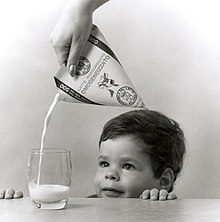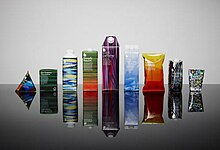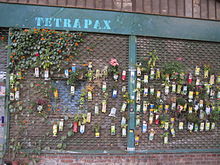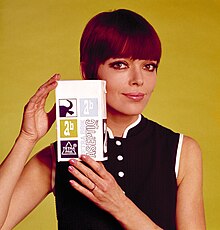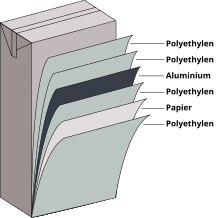Tetra pack
| Tetra Pak International SA
|
|
|---|---|
| legal form | Corporation |
| founding | 1951 |
| Seat |
Pully Switzerland |
| management | Adolfo Orive ( CEO and Chairman of the Board of Directors ) |
| Number of employees | 24,100 |
| sales | EUR 11.865 billion (2015) |
| Branch | Packaging manufacturer |
| Website | tetrapak.com |
Tetra Pak is an international Swiss company with Swedish roots that manufactures and sells systems for industrial food processing and packaging as well as food packaging itself. The brand name found its way into German usage as a generic name for beverage cartons .
The company is part of the Tetra Laval Group and its largest sub-division.
The headquarters of the Tetra Laval Group and the Tetra Pak International company are now located in Pully near Lausanne in Switzerland. Tetra Pak employs 24,100 people and had a turnover of 11.9 billion euros in 2015.
development
In 1943 the young chemist Erik Wallenberg , the engineer Harry Järund and the sales manager Erik Torudd succeeded in developing a completely new packaging for milk - a carton packaging in the shape of a tetrahedron . The idea for this was the Swede Ruben Rausing , in whose company the three worked at the time. The shape of the tetrahedron and the technology were to become decisive for the development of the company, because Rausing and Wallenberg had developed a new coating of paper with plastic and a special sealing technique that took into account the nature of the liquid to be packaged. This new form of packaging came onto the market on May 18, 1951. Depending on the product and manufacturer, this cardboard packaging is coated differently.
The name of the company comes from the original tetrahedron shape that the pack used to take on due to the manufacturing process: an already filled cardboard tube is twisted by 90 degrees, clamped, welded and cut. The shape and closure of the packaging have changed since then. Tetra-Pak beverage cartons for milk, fruit juice beverages and table wine are now available in the form of a compact cuboid . These so-called Tetra Brik packaging in the form of a brick ( brick = eng . For bricks ) were fitted to 1998 with a perforation at one of the folded corners of the carton. After lifting the perforated corner, the packaging could be opened by kinking at the perforation. This opening integrated into the box has been replaced since 1998 by resealable openings with plastic closures made of polyethylene under the names "ReCap", "SimplyPull" and "SimplyTwist". Tetra-Pak also offers screw caps under the name “Tetra Top”, where the entire top of the packaging is made of polyethylene. At the same time, the packaging of some products in the traditional brick shape has been replaced by Tetra Brik packaging with a square footprint, which is higher than the previous packaging and therefore requires a greater distance between the shelves in the refrigerator.
Company formation and locations
In 1951 the predecessor company Åkerlund & Rausing was bought up. It was founded by Erik Wallenberg and Ruben Rausing and is based in Lund , Sweden , as a public limited company (aktiebolag) .
Tetra Pak Germany has been based in Hochheim am Main since 1965 with the parent company Tetra Pak GmbH & Co. KG and Tetra Pak Management GmbH . Production facilities were established in Limburg an der Lahn in 1969 and in Berlin in 1981 . The Berlin location was closed at the end of 2013 and the production of milk packaging relocated to Limburg.
The company has been running its own research laboratory for food chemistry in Stuttgart since 1973, which is primarily used for quality control. There is a separate subsidiary for each location.
In 1981 the company relocated to Lausanne.
The Tetra Pak brand
The Swedish brand "Tetra Pak" has enjoyed trademark protection through registered trademarks since 1951. The first word mark “Tetra Pak” was registered in Sweden in 1950 and is the name of the company. The company's founders also secured the trademark rights for the beverage cartons developed over the years: Tetra Classic, Tetra Brik, Tetra Rex, Tetra Prisma, Tetra Top, etc. a. Further national and international trademark registrations followed.
The Tetra Pak brand is registered in favor of the Tetra Pak group. The Tetra Pak word mark has enjoyed trademark protection in Germany since 1957. The Tetra Pak Group not only protects its word marks, but also the appearance of its packaging through three-dimensional trademarks and designs . In addition, their logos and other trademarks are protected worldwide.
The group owns a total of 70 different brand families and its brand portfolio comprises over 12,000 brand registrations worldwide. The slogan used by the company "Protect what is good" was found to be protectable by the Federal Patent Court in 2010. The slogan is used on Tetra-Pak packaging worldwide.
Tetra Pak was the shirt sponsor of the Bundesliga club Eintracht Frankfurt from 1993 to 1996 .
Core business of long-life milk
With the presentation of the first packaging system for the aseptic filling of aseptic milk in 1961 in Switzerland , Tetra Pak achieved its breakthrough in Europe. Changes in lifestyle had increased the need for longer-life long - life milk in addition to the usual pasteurized products, so that a steadily growing production was mapped out all over the world.
Alternative concept of hose packaging
Between 1960 and the 1990s, dairies tried to establish tubular packaging for fresh milk without lasting success . This alternative to the beverage carton has not caught on with consumers because hoses are less practical to store than carton packaging. A plastic container always had to be kept ready for open hoses, and no closure was provided. However, critics emphasize the lower environmental impact of tubular packaging, which is made of pure plastic and is easier to recycle than multi-layer packaging materials such as beverage cartons.
Children's fruit juices, milk and cream
In the mid-1960s, the German population got to know the Tetra Pak carton in its eponymous tetrahedron shape ("Tetra Classic") for Sunkist fruit juice drinks, the production of which began on May 26, 1964. The shape should allow a secure stand, the pre-made perforation hole and the drinking straw a drip-free drinking. There was also the tetrahedral 0.5 lH milk pack for the household.
For decades in the GDR there were both milk drinks for school children and coffee cream ( condensed milk ) in tetrahedral packaging using the original filling technology. There were also stackable hexagonal plastic boxes, as the tetrahedra cannot be stacked in cuboid boxes.
Alternative concept of foil bags
As a result of an elaborate advertising campaign, the tube-like foil pouch packaging with the fruit juice drink Capri-Sonne also became popular in 1969 . In order to compensate for the disadvantage of the tubular packaging , a support fold was incorporated which, together with the composite construction of aluminum + thermoplastic film, ensured a reasonably secure stand.
Further development
In 2002, Tetra-Pak sold around 98 billion packs for 56 billion liters of filled products worldwide, generating sales of almost 7.5 billion euros.
In 2003 the company had branches in 165 countries with a total of almost 21,000 employees. The dairy sector alone accounted for 62 percent of sales, in which the group has a market share of 85 percent.
In Germany, the packaging company became known to end consumers thanks to a successful advertising campaign with the slogan “Tetra Pak - Somehow clever!”.
In 2004, the advertising statement focused particularly on opacity and thus the decisive advantage over glass and film packaging in terms of shelf life, but also on the preservation of vitamins in milk and fruit juices.
There have been frequent changes to the packaging over time. For the introduction, mostly folded flaps were used, which have to be folded up. The gable fold was then used for rectangular cardboard boxes. For some years now, resealable spouts and screw caps have been used more and more.
Expansion of the product range
After all possible end products from applesauce to citrus juice have also been offered in Tetra Pak beverage cartons over the years, the company has placed great emphasis on offering coated cardboard packaging ("Tetra Recart") for foods that have long been reserved for cans to be able to. Packaging for vegetable products is now an additional market segment. A well-known customer is the Bonduelle company .
classification
Tetra Pak is now the market leader in cardboard beverage packaging. B. in long-life milk packaging a market share of 82%. For beverage packaging, the company's best-selling product is the so-called Tetra Brik packaging , which is commonly known as Tetra-Pak or Tetrapak . It is a square-shaped packaging in which liquid or low-viscosity foods are transported and sold. It consists of cardboard coated with plastic film and, depending on the application, also with aluminum foil . The plastic film prevents the carton from becoming soggy and the aluminum from being attacked by acidic liquids such as fruit juice. The aluminum foil ensures that the cardboard is impermeable to light and oxygen.
The Tetra Brik packaging was patented in the United States on January 9, 1990. The term of protection expired on August 24, 2008. Since then, other companies have been able to copy this beverage packaging.
Environmental sustainability
The use of composite materials is controversial from an environmental point of view. Tetra Pak aggressively advertises the environmental aspects of the beverage cartons (sustainable wood, low weight), although there are hardly any reliable figures as to the extent to which the waste is actually recycled. In addition, there was a scandal in 2005 about beverage cartons, among others from Tetra Pak, which were contaminated by printing with the ITX chemical . The FSC label is used to guarantee sustainable forest management .
The Tetra Laval Group
In 1993 Tetra Pak merged with Alfa Laval to form the Tetra Laval Group. Since then, the group’s range has also included various processing plants as well as equipment, accessories and services for dairy farms. Part of the Alfa Laval company will continue to operate as a subsidiary of the Tetra Laval group under the name DeLaval , the remaining part was sold in 2000 and is now an independent, publicly traded group. The Tetra Laval Group has also owned the PET bottle manufacturer Sidel since 2003 . The Tetra Pak company is divided into the areas of Packaging (filling systems) and Processing (processing systems). Alfa Laval is again independent as a component supplier.
The name Alfa Laval refers to the company founder Gustav de Laval ; the Alfa is only part of the logo.
Web links
- Official website (Germany)
Individual evidence
- ^ Entry of "Tetra Pak International SA" in the commercial register of the canton of Vaud
- ↑ https://www.tetrapak.com/de/about/history
- ↑ https://www.tetrapak.com/de/about/tetra-pak-management-team
- ↑ As of 12/2017 https://www.tetrapak.com/de/about/facts-figures
- ↑ a b Tetra Laval annual report 2015/2016. (PDF) Retrieved December 21, 2016 .
- ^ "Tetrapak" in the Duden ( Memento from June 25, 2011 in the Internet Archive ) - accessed on September 17, 2013.
- ↑ Michael Fink: Der, die, or the Tetrapak . In: wamiki. The educational specialist magazine . No. 1 , 2016, ISSN 2363-7714 .
- ↑ Luc de Grauwe: "Isn't it good, Norwegian wood?" References and recent borrowings from Nordic into West Germanic . In: Linguistics online . tape 8 , no. 1 , 2001, doi : 10.13092 / lo.8.975 ( bop.unibe.ch [accessed on April 13, 2020]).
- ↑ https://www.tetrapak.com/de/about/facts-figures
- ↑ a b The Swedish Institute (SI) ( Memento from October 25, 2007 in the Internet Archive ) PDF document, page 2, article on the history of Tetra Pak
- ↑ Tetrapak is struggling with a shrinking market . wiwo.de; accessed on January 23, 2015
- ↑ Trademark registration at the German Patent and Trademark Office
- ↑ see register of the German Patent and Trademark Office , the Office of the European Union for the registration of trademarks and designs , or the World Intellectual Property Organization
- ↑ "Protect what is good"
- ↑ Data and facts , Tetra Pak website
- ↑ Packaging for milk and fruit juices (PDF) Tetra Pak website, p. 13
- ^ System for dispensing liquid from a paperboard carton
- ↑ Recycling is only the second best way . In: Der Spiegel . No. 25 , 1993 ( online ).
- ^ German environmental aid
- ↑ Tetra Laval ( Memento of the original from June 24, 2007 in the Internet Archive ) Info: The archive link was automatically inserted and not yet checked. Please check the original and archive link according to the instructions and then remove this notice.


